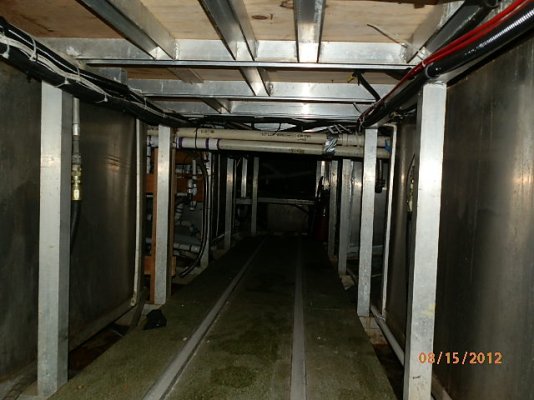aronhk_md
Senior Member
I have two approximately 200 gallon aluminum fresh water tanks on Belladonna so 400 gallons. One has a leak, and considering they are 44 years old, who knows about the other. They look perfect on the outside, but...
Ideally fixing them would be great. They only have small access panels maybe 5 inches across, so getting into them isn't possible. I cant get to them from above without ripping up the floor above, and they aren't removable in one piece. I MIGHT be able to jack them up a few inches to be able to weld in patches, but concerned I might not be able to get to the areas that need repair, and I might just spend days of work only to be frustrated. I could potentially cut open the sides, repair from inside, then weld them back up again........maybe??? lol
Of course there is the possible link between aluminum and Alzheimer's to think of too. lol
My thought had been to cut the tanks out, maybe just leaving the bottom panel of each tank as a handy platform. IF I replaced them with plastic tanks (yes there are health concerns with plastic too...lol...can you tell I am in the medical field?) I have two separate questions about the replacement.
1) How much fresh water do I need?
I am considering living aboard, which means during winter months you have to unroll a hose to fill the tanks from a distant source, empty the hose and store it. Not fun if the weather sucks. Which means I might want lots of water storage........but........
Storing lots of water on board means the below decks compartment needs to be kept warm enough to prevent freezing, and if I recall correctly it takes a lot more energy to keep water warm than air, so am I creating an energy sink by keeping too much water on board?
2) Depending on how much water I end up needing, I need tanks (if I don't repair what I have). Has anyone thought about using the 55 gallon food barrels I see available on craigslist all the time for $10-$20 each for water storage? They are very heavily made and I THINK could be interconnected with bulkhead fittings.
Just wondering as I'm always trying to think outside the box, and sometimes the ideas are great, while other times..............................lol
In the picture they are the far set of tanks and hard to see, but the pic gives you an idea of the space involved. The closer tanks are 300 gallon fuel tanks each which are 6 ft long and 33" tall.
Ideally fixing them would be great. They only have small access panels maybe 5 inches across, so getting into them isn't possible. I cant get to them from above without ripping up the floor above, and they aren't removable in one piece. I MIGHT be able to jack them up a few inches to be able to weld in patches, but concerned I might not be able to get to the areas that need repair, and I might just spend days of work only to be frustrated. I could potentially cut open the sides, repair from inside, then weld them back up again........maybe??? lol
Of course there is the possible link between aluminum and Alzheimer's to think of too. lol
My thought had been to cut the tanks out, maybe just leaving the bottom panel of each tank as a handy platform. IF I replaced them with plastic tanks (yes there are health concerns with plastic too...lol...can you tell I am in the medical field?) I have two separate questions about the replacement.
1) How much fresh water do I need?
I am considering living aboard, which means during winter months you have to unroll a hose to fill the tanks from a distant source, empty the hose and store it. Not fun if the weather sucks. Which means I might want lots of water storage........but........
Storing lots of water on board means the below decks compartment needs to be kept warm enough to prevent freezing, and if I recall correctly it takes a lot more energy to keep water warm than air, so am I creating an energy sink by keeping too much water on board?
2) Depending on how much water I end up needing, I need tanks (if I don't repair what I have). Has anyone thought about using the 55 gallon food barrels I see available on craigslist all the time for $10-$20 each for water storage? They are very heavily made and I THINK could be interconnected with bulkhead fittings.
Just wondering as I'm always trying to think outside the box, and sometimes the ideas are great, while other times..............................lol
In the picture they are the far set of tanks and hard to see, but the pic gives you an idea of the space involved. The closer tanks are 300 gallon fuel tanks each which are 6 ft long and 33" tall.
Attachments
Last edited:



